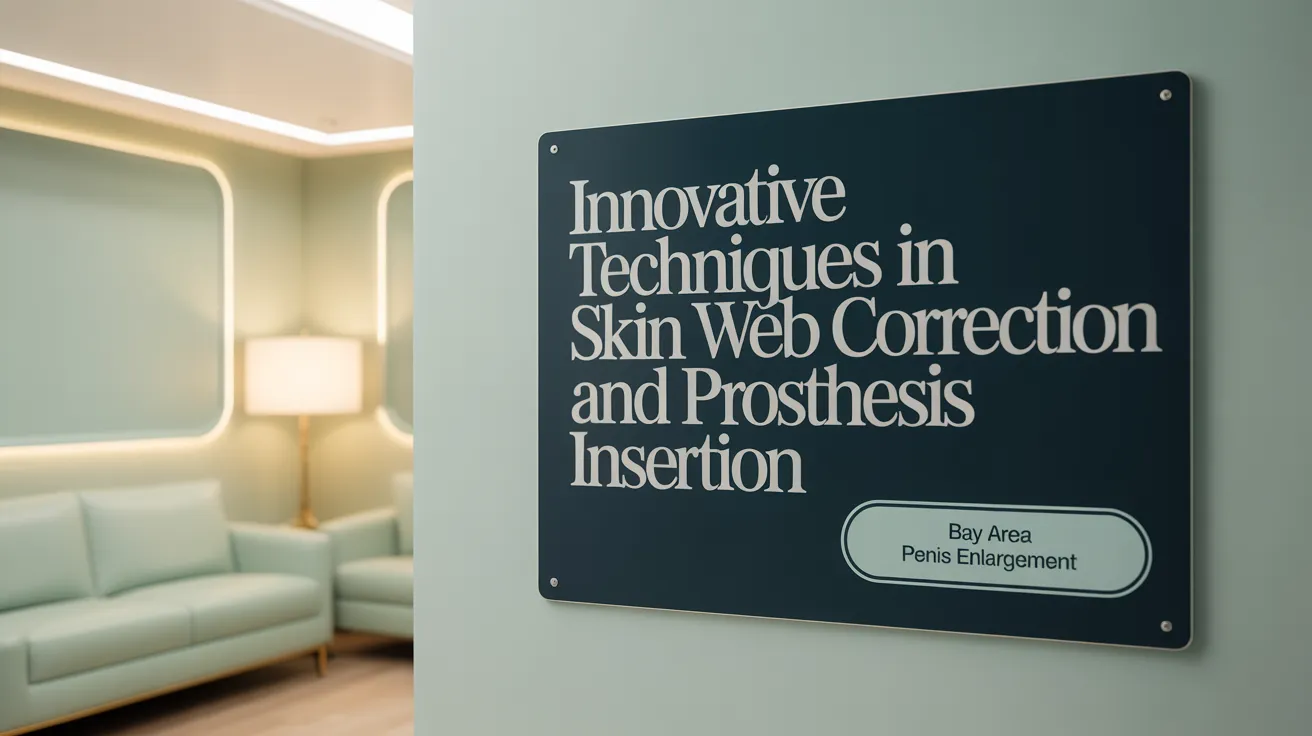Understanding Scrotal Enhancement: More Than Meets the Eye
Scrotal enhancement procedures have evolved beyond mere cosmetic improvements, addressing functional issues that impact urinary health, sexual satisfaction, and psychological well-being. This article explores the diverse surgical and non-surgical options now available, along with their potential benefits, risks, and recovery processes, to provide a comprehensive overview of how scrotal enhancement can improve quality of life.
Anatomy, Common Issues, and Patient Evaluation in Scrotal Enhancement

What is the importance of scrotal anatomy in aesthetic and functional outcomes?
The scrotum is a key structure in male genital anatomy, serving both protective and regulatory functions for the testicles. It consists of skin, connective tissue, and muscles like the dartos and cremaster muscles that control its laxity and temperature regulation. Proper scrotal anatomy is essential not only for testicular health but also for the aesthetic harmony of the male genitalia. Changes in scrotal morphology such as laxity, sagging, or webbing can affect sexual function, comfort, and self-confidence. For detailed information, see Aesthetic surgery of the male genitalia and Scrotal aesthetics importance.
What are common scrotal conditions that may require enhancement or correction?
Frequent issues leading to scrotal surgery include:
- Buried or hidden penis often associated with excess pubic fat or skin descent
- Sagging or enlarged scrotum due to aging, trauma, congenital factors, or medical conditions like hydrocele
- Penoscrotal webbing, wherein skin extends abnormally onto the penile shaft, potentially impairing aesthetics and function
- Skin conditions or defects resulting from infections (e.g., Fournier’s gangrene), injury, or previous surgeries
- Testicular loss or absence requiring scrotal reconstruction and prosthetic implantation
These conditions and their surgical management are discussed in Scrotoplasty procedure, Penoscrotal webbing correction, and Scrotal reduction surgery.
How is patient evaluation conducted for scrotal enhancement procedures?
Assessment begins with a detailed medical, surgical, and sexual history alongside physical examination focusing on urinary, sexual, and testicular function. Evaluation includes measuring scrotal size and skin laxity, examining for conditions like hydroceles or masses, and assessing for psychological factors such as body image concerns or dysmorphophobia. Understanding patient expectations and functional disabilities is critical. Psychological assessment may be indicated for patients dissatisfied despite normal anatomy. For comprehensive patient evaluation guidance, see Evaluation of male genitalia surgery patients and Psychological considerations in penile surgery.
What psychological and functional considerations are important in treatment planning?
Patients’ self-esteem and sexual identity are closely tied to genital appearance and function. Treatment planning balances aesthetic improvement with preservation or restoration of urinary and sexual function. Counseling about realistic outcomes, potential risks, and alternative therapies including psychological support is fundamental to successful results. For patients with dysmorphic concerns, referral to mental health professionals is recommended prior to surgical intervention. Further information is available in Aesthetic surgery of male genitalia and Penile enhancement surgery recommendations.
Surgical Procedures for Scrotal Enhancement: Techniques and Indications

What is scrotoplasty and when is it indicated?
Scrotoplasty is a surgical procedure aimed at correcting various scrotal conditions such as sagging, enlargement, buried penis, and penoscrotal webbing. It involves removing excess skin and tightening the scrotal sac to restore comfort and aesthetics.
Many men seek scrotoplasty for congenital abnormalities, post-surgical or obesity-related buried penis, or cosmetic concerns related to excess scrotal skin. The surgery typically uses incisions near the penis and scrotum to excise excess tissue and may incorporate tightening or reconstruction measures. Recovery usually includes wearing support garments and abstaining from sexual activity for 2 to 3 weeks.
How are scrotal reduction and lift procedures performed?
Scrotal reduction, also called scrotal lift, focuses on eliminating excess skin to reduce scrotal size and improve appearance and comfort. This outpatient surgery takes 1-2 hours under general anesthesia. It entails careful removal of loose skin and sometimes underlying fascia, with meticulous hemostasis to minimize complications like hematoma.
Risks include bleeding, infection, and scarring, but satisfaction rates are generally high. The procedure can help alleviate discomfort such as skin chafing and improve sexual confidence.
What techniques are used for penoscrotal web correction?
Penoscrotal webbing involves excess skin attaching the scrotum to the penile shaft, potentially impairing appearance and sexual function. Correction methods include triangular skin excision combined with advanced techniques like Z-plasty or V-Y advancement flaps.
These techniques help prevent scar contracture and preserve blood supply, improving surgical success and cosmetic outcomes. Z-plasty rearranges tissue to release tension, while V-Y flaps allow skin advancement and coverage.
When are testicular prostheses inserted and what reconstruction options exist?
Testicular prosthesis insertion addresses testicular loss due to trauma, illness, or birth defects. The FDA-approved Torosa implant resembles natural testicles in look and feel. Surgery is brief (20-40 minutes), usually outpatient, with a recovery phase involving swelling and tenderness.
In scrotal reconstruction, particularly after injuries or skin loss from infections like Fournier's gangrene, techniques include skin grafting and tissue expansion. Autologous tissue flaps may be used to minimize complications related to implants, providing natural-like augmentation and improved aesthetics (source, source).
What is the role of surgical-grade silicone expanders in scrotal expansion?
For patients with a hypoplastic or small scrotum, surgical-grade silicone scrotal expanders are employed to enlarge the scrotal sac gradually. The expander is inserted under sterile conditions and slowly inflated over 4-8 weeks to stretch scrotal skin and tissue.
This minimally invasive technique boasts over 90% success and low risks of infection, bleeding, or erosion. Patients usually experience minimal pain and can quickly resume sexual and daily activities. This method complements other scrotal and penile enhancement procedures to restore functional and aesthetic balance.
Minimally Invasive and Non-Surgical Scrotal Enhancements

What are the injectable options such as hyaluronic acid fillers (ScroFill)?
One popular minimally invasive procedure for scrotal enhancement is the injection of hyaluronic acid fillers, marketed as ScroFill. Hyaluronic acid is a substance naturally produced in the body, making these injections generally safe and well-tolerated. ScroFill targets the dermal layer of the scrotum to increase size and fullness, improving overall aesthetic appearance. The treatment is typically painless, non-invasive, and outpatient, with results lasting about 2 to 3 years. Common temporary side effects include minor swelling, bruising, and soreness.
How does Scrotox™ (botulinum toxin) help with muscle relaxation and sweat reduction?
Scrotox™ involves injecting botulinum toxin (Botox) into the scrotal muscles, which relaxes the dartos muscle and reduces muscle tension. This results in a smoother, less wrinkled scrotal appearance with a lower-hanging scrotum. Additionally, Scrotox™ effectively reduces excessive sweating (hyperhidrosis), alleviating discomfort and boosting confidence. The procedure is minimally invasive, lasting about 20-30 minutes, with effects lasting up to six months. Some mild side effects can include swelling, bruising, and rare cases of altered sensation. More details about benefits and procedure can be found in Scrotox treatment information and Scrotox patient guide.
What are the advantages and limitations of non-surgical approaches?
Minimally invasive treatments offer the benefits of being relatively quick with minimal downtime and lower risk compared to surgery. They preserve natural tissue and function, with an easy recovery process. However, limitations include temporary results requiring maintenance treatments, lesser volume enhancement compared to surgical options, and variable patient satisfaction based on expectations. These treatments do not address all scrotal conditions, such as significant excess skin or severe structural concerns. For comprehensive understanding of penile and scrotal enhancement techniques, see Male genital aesthetic procedures overview and Scrotal aesthetics scientific insight.
Who is a suitable candidate for minimally invasive scrotal enhancement treatments?
Ideal candidates are men in good general health seeking aesthetic or functional improvement without undergoing surgery. These include individuals experiencing mild scrotal laxity, volume loss due to aging or testicular atrophy, or excessive scrotal sweating. Patients must have realistic expectations and be free from active infections or allergies to treatment substances. Consultation with a qualified healthcare provider ensures suitability and tailored treatment plans. More information on scrotal enlargement procedures and candidate suitability can be found at Scrotum enlargement procedures and Minimally invasive urological treatments.
Risks, Complications, and Management in Scrotal and Genital Enhancements
What complications are associated with scrotal surgeries and penile augmentation?
Scrotal surgeries such as scrotoplasty and scrotal lift typically address excess skin, sagging, or congenital abnormalities. Common risks include bleeding, infection, hematoma formation, nerve injury, scarring, and pain during intercourse. Hematoma is frequently reported and requires careful surgical technique to avoid.
Penile augmentation procedures, especially those involving fat or foreign material injections, can lead to complications such as penile deformity, edema, curvature, subcutaneous masses, infection, non-healing wounds, and sexual dysfunction. Minor complications occur rarely with newer techniques, but severe adverse outcomes are documented, particularly from unlicensed injections (Complications of Genital Enlargement Surgery, Genital Enlargement Surgery Risks).
What are known risk factors for genital enhancement complications?
Risk factors include:
- Use of unlicensed or non-medical substances like silicone, mineral oils, and paraffin (Male genital enhancement risks)
- Patient history of previous procedures
- Surgical site infections and poor wound healing
- Inadequate hemostasis leading to hematoma
- Lack of proper aseptic technique
- Patient comorbidities such as obesity or diabetes
- Inexperienced practitioners performing procedures outside regulated settings (Genital enlargement surgery complications)
What are examples of severe complications from unlicensed injections?
Cases involving subcutaneous silicone or other foreign material injections outside medical supervision have resulted in serious complications including:
- Siliconoma formation with inflammatory reactions
- Migration and hardening of material leading to painful deformities
- Penile shortening and loss of function
- Ulceration and chronic wounds
- Need for multiple corrective surgeries involving tissue excision and skin grafting (Complications of penile and scrotal foreign material injections)
Why is patient counseling and informed consent critical?
Given the risk profile and experimental nature of many genital enhancement procedures, it is vital to counsel patients thoroughly. Counseling should cover realistic expectations, potential complications, the possibility of revision surgeries, and emphasize safer, evidence-based alternatives where available (Aesthetic surgery of the male genitalia, The pros and cons of penile enhancement).
How are adverse effects managed and corrected?
Management typically involves surgical removal of foreign materials, treatment of infections, correction of deformities, and skin graft reconstruction when necessary. Revision surgeries may include reversal of previous procedures such as ligament release or removal of grafts. Post-correction outcomes generally show improved appearance and function but rarely restore the original status fully (Revision surgery for penile augmentation, Corrective surgery for penile complications.
Comprehensive perioperative care and referral to specialized centers improve outcomes and reduce the risk of long-term morbidity (Perioperative counseling and complication management).
Postoperative Care and Recovery Following Scrotal Procedures
Typical Recovery Timelines and Activity Restrictions
Recovery after scrotal surgery typically involves managing swelling and pain for several weeks. Most patients avoid strenuous activity, including heavy lifting and sexual activity, for about 2 to 3 weeks to facilitate healing. Some may require brief hospitalization, but many procedures are outpatient with discharge the same day (Scrotoplasty recovery process, Postoperative recovery after scrotal surgery).
Pain Management and Swelling Reduction Techniques
Pain is usually controlled with over-the-counter analgesics like acetaminophen or NSAIDs unless stronger prescription medication is required. Ice packs are commonly applied during the first 24–48 hours to reduce swelling and discomfort. Elevating the scrotum and wearing supportive garments further minimize swelling (Post-operative care for penoplasty, Scrotoplasty post-operative pain management).
Support Garments and Hygiene Care
Supportive underwear or a scrotal support (such as a jockstrap) is recommended for at least two weeks to maintain position and reduce strain on surgical sites. Patients are advised to shower after 24 hours but should avoid baths or swimming until incisions have healed, usually about one week. Daily gentle washing of the incision sites with warm water is important, avoiding harsh chemicals (Scrotoplasty postoperative care, Wearing scrotal support post-surgery.
Monitoring for Complications and Follow-Up Protocols
Patients should watch for signs of infection (redness, discharge, fever), difficulty urinating, or unusual pain and report these immediately. Follow-up visits typically occur within two to four weeks post-surgery to assess healing. Managing constipation and maintaining hydration helps prevent straining and promotes recovery (Postoperative care after scrotal surgery, Signs of surgical complications).
Impact on Sexual Function and Urinary Health
Scrotal procedures often improve comfort and self-esteem and may enhance urinary function, especially in cases of buried penis or excessive scrotal skin. Sexual activity is usually resumed around 2 to 3 weeks post-surgery, with no long-term negative effects on function expected when care instructions are followed properly (Scrotoplasty benefits, Correction of buried penis).
Psychological and Functional Benefits of Scrotal Enhancement
How does scrotal enhancement improve self-esteem and body image?
Scrotal enhancement procedures, such as scrotoplasty and scrotal rejuvenation, significantly boost self-esteem by addressing aesthetic concerns like sagging or asymmetry. Many men experience enhanced body image and increased confidence following treatment, which positively impacts sexual satisfaction and overall psychological well-being.
What are the functional benefits of scrotal enhancement?
Beyond aesthetics, scrotal surgeries can improve functionality, including easier urination and greater comfort during sexual activity. Correcting issues like buried penis or penoscrotal webbing often results in improved hygiene and reduced physical discomfort, enhancing daily life quality.
How does treating congenital and acquired deformities affect quality of life?
Surgical intervention for congenital conditions (e.g., webbed penis) or acquired problems (e.g., scrotal sagging from aging or trauma) restores normal anatomy and function, reducing physical limitations and psychological distress. These improvements support broader health and social confidence.
Why is a holistic approach important?
Combining psychological counseling with medical interventions ensures realistic expectations and addresses underlying body image issues. This comprehensive care model aids in patient satisfaction and optimal outcomes, especially in individuals with body dysmorphic concerns related to genital appearance, as detailed in studies on aesthetic surgery of the male genitalia and psychological assessment before genital surgery.
Future Directions and Innovations in Scrotal Surgery and Enhancement
Advancements in Tissue Engineering and Regenerative Medicine for Scrotal Tissue
Recent progress in tissue engineering offers promising solutions for scrotal reconstruction and enhancement. Techniques using autologous fibroblasts cultured on biodegradable scaffolds are under investigation to regenerate scrotal tissue with improved aesthetic and functional outcomes, reducing risks of rejection and complications seen with traditional grafts (Tissue engineering with autologous fibroblasts, PLGA scaffolds for penile girth.
Emerging Minimally Invasive Technologies Enhancing Patient Safety and Outcomes
Minimally invasive procedures, such as injectable fillers like hyaluronic acid-based products and Botox injections (Scrotox™), are gaining popularity due to their safety, reduced recovery times, and efficacy in improving scrotal appearance and comfort. These methods provide alternatives to surgery with fewer risks and quicker return to daily activities (ScroFill scrotum filler, Scrotox treatment, Botox injections in the scrotum).
Integration of Personalized Medicine in Treatment Planning
Personalized medicine approaches that consider individual anatomy, health status, psychological factors, and aesthetic goals are becoming integral to scrotal surgery. Tailoring interventions ensures optimized results and patient satisfaction while minimizing complications (Scrotum enlargement procedures, Scrotoplasty and combined penile and scrotal treatments).
Trends in Combining Aesthetic and Functional Procedures for Comprehensive Care
Combining scrotal surgeries (like scrotoplasty and scrotal lift) with penile enhancement or functional urological treatments allows for holistic management of male genital health. This trend reflects the emphasis on both appearance and function, improving confidence, sexual satisfaction, and overall quality of life (Scrotoplasty surgical procedure, Scrotal lift procedure, Penile enhancement and scrotal aesthetics comprehensive care, Penile implant overview).
Comprehensive Care in Scrotal Enhancement: Balancing Function and Aesthetics
Scrotal enhancement is a sophisticated field that merges surgical expertise with personalized patient care to address both aesthetic desires and functional necessities. By combining cutting-edge surgical techniques, minimally invasive treatments, and thorough patient education, modern approaches offer men improved confidence, comfort, and quality of life. As advancements continue, integration of innovative therapies and holistic care will be essential to optimize outcomes and minimize risks in this specialized area of male genital health.

